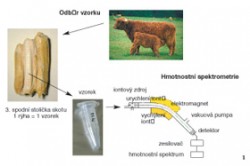Archeologové často diskutují o pohybu obyvatel na určitém území a spolu s antropology, archeozoology a archeobotaniky uvažují o spektru rostlin a zvířat sloužících k výživě lidí v dávné minulosti. V posledních desetiletích do těmto studií proniká nová technika, a to měření kvantitativních poměrů obsahu přirozených izotopů vybraných prvků (např. uhlík, kyslík, stroncium) obsažených v tkáních, kostech a zubech.
Benson S., Lennard Ch., Maynard Ph., Roux C. (2006): Forensic applications of isotope ratio mass spectrometry. A review Forensic Science International. 157. 1–22.
Bocherens H., Fogel M., Tuross N., Zeder M. (1995): Trophic structure and climatic information from isotopic signatures in Pleistocene cave fauna of southern England. Journal of Archaeological Science. 22.327–340.
Bocherens H., Billioua D., Mariotti A., Toussaint M., Patou-Mathis M., Bonjean D., Otte M. (2001): New isotopic evidence for dietary habits of Neandertals from Belgium. Journal of Human Evolution. 40. 6. 497-505.
Carvalho M.L.,Marques J.P.,Marques A.F., Casaca C. (2004): Synchrotron microprobe determination of the elemental distribution in human teeth of the Neolithic period. X-Ray Spectrom. 33. 55–60.
Carvalho M.L., Marques A.F, Marques J.P., Casaca C. (2007): Evaluation of the diffusion of Mn, Fe, Ba and Pb in Middle Ages human teeth by synchrotron microprobe X-ray fluorescence. Spectrochimica Acta Part B. Atomic Spectroscopy. 62.6-7. 702-706.
Dürrwächter C., Craig O.E., Collins M.J., Burger J., Alt K.W. (2005): Beyond the grave: variability in Neolithic diets in Southern Germany? Journal of Archaeological Science. 33. 39-48.
Körner C., Farquhar G.D., Wong S.C. (1991): Carbon isotope discrimination by plants follows latitudinal and altitudinal trends. Oecologia. 74. 623-632.
LeHuray J.D., Schutkowski H. (2005): Diet and social status during the La Tène period in Bohemia:Carbon and nitrogen stable isotope analysis of bone collagen from Kutna´ Hora-Karlov and Radovesice. Journal of Anthropological Archaeology. 24.135–147.
Lee-Thorp J., Sponheimer, M. (2006): Contributions of Biogeochemistry to Understanding Hominin Dietary Ecology. Yearbook of Physical Anthropology 49:131–148.
Lillie M., Jacobs K. (2006): Stable isotope analysis of 14 individuals from the Mesolithic cemetery of Vasilyevka II, Dnieper Rapids region, Ukraine. Journal of Archaeological Science. 33. 880-886.
O´Leary M.H. (1988): Carbon isotopes in photosynthesis. Bioscience. 38. 328-336. Owen-Smith, R.N., 1988. Megaherbivores. Cambridge University Press. Cambridge.
Price T.D., Knipper C., Grupe G., Smrčka V. (2004): Strontium Isotopes and Prehistoric Human Migration: The Bell Beaker Period in Central Europe. European journal of Archaeology. 7.1. 9-40.
Rauch S., Rummel S., Lehn Ch., Büttner A. (2007): Origin assignment of unidentified corpses by use of stable isotope ratios of light (bio-) and heavy (geo-) elements—A case report. Forensic Science International. 168. 2-3. 215-218.
Rebocho Ch., Carvalho M.L., Marques A.F., Ferreira F.R., Chettle D.R. (2006): Lead post-mortem intake in human bones of ancient populations by 109Cd-based X-ray fluorescence and EDXRF. Talanta. 70. 957–961.
Richards M.P., Pettitt P.B., Trinkaus E., Smith, F.H., Paunovic M., Karavanic I. (2000): Neanderthal diet at Vindija and Neanderthal predation: The evidence from stable isotopes. Proc Natl Acad Sci USA. 97. 7663–7666.
Richards M.P., Fuller B.T., Hedges R.E.M. (2001): Sulphur isotopic variation in ancient bone collagen from Europe: implications for human palaeodiet, residence mobility, and modern pollutant studies. Earth and Planetary Science Letters. 191. 185-190.
Schwarcz H.P., Dupras T.L., Fairgrieve, S.I. (1999): 15N enrichment in the Sahara: In search of a global relationship. Journal of Archaeological Science. 26. 629-636.
Smrčka V., Brůžek F., Erban V., Berkovec T., Dočkalová M., Neumanová K., Nývltová-Fišárková M. (2005): Carbon, nitrogen and strontium isotopes in the set of skeletons from the neolithic settlement at Vedrovice (Czech Republic). Anthropologie. 43/2-3. 315-323.
Sponheimer M., Lee-Thorp J. (2007): 18 Hominin Paleodiets: The Contribution of Stable Isotopes. IN. Henke, W., Tattersaal, Y., Hardt, T. (Eds). Handbook of Paleoanthropology. Springer Publishing. 555-585.
Sternberg L., DeNiro M.J., Johnson H.B. (1984): Isotope ratios of cellulose from plants having different photosynthetic pathways. Plant Physiology. 74. 557-561.
Strott N. (2006): Paläodemographie frühmittelalterlicher Bevölkerungen Altbaierns. Diachrone und allopatrische Trends. PhD Diss. University München.
Thomson A.H., Richards M.P., Shortland A., Zakrzewski S.R. (2005): Isotopic palaeodiet studies of Ancient Egyptian fauna and humans. Journal of Archaeological Science. 32. 451–463.
Tykot R.H. (2004): Stable isotopes and diet: You are what you eat. Proceedings of the International School of Physics “Enrico Fermi”Course CLIV.Martini, M., Milazzo,M. et Piacentini, M. (Eds.) IOS Press. Amsterdam. 433-444.
Tykot R.H. (2006): Stable isotope analysis and human diet. 10. Isotope Analyses and the Histories of Maize. In: Staller, J.E., Tykot, R.H., Benz, B.F. (Eds). Histories of Maize. Multidisciplinary Approaches to the Prehistory, Linguistics, Biogeography, Domestication, and Evolution of Maize. Elsevier Publishing. 131-139.
Yurtsever Y., Gat, J.A. (1981): Atmospheric waters. In: Gat, J.R. et Gonfiantini, R. (Eds.). Stable Isotope Hydrology — Deuterium and Oxygen-18 in the Water Cycle. IAEA, Int. Atomic Energy Agency Tech. Rept. Ser. 103–142.
Archaeologists very often discuss movements of inhabitants in the particular area and together with anthropologists consider the range of plants and animals used for human feeding in the past. New techniques have been applied in the relevant studies, such as the quantitative estimation of natural isotope levels in particular elements (e.g. carbon, oxygen, strontium) found in tissues, bones and teeth.
 Odběr vzorků z bioapatitu zubní skloviny a jejich měření. Orig. L. Kovačiková / © L. Kovačiková
Odběr vzorků z bioapatitu zubní skloviny a jejich měření. Orig. L. Kovačiková / © L. Kovačiková


